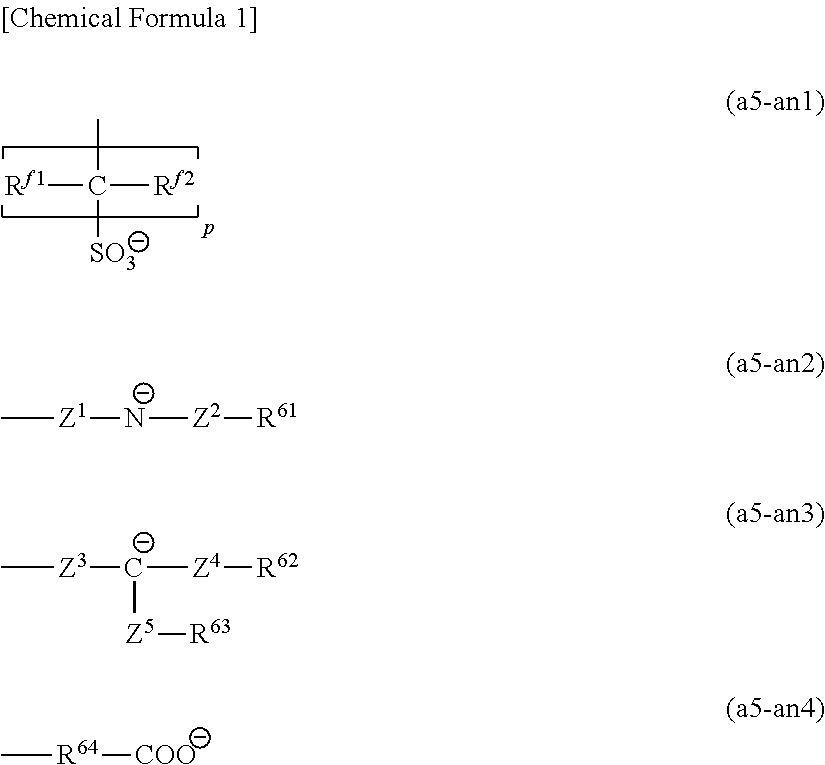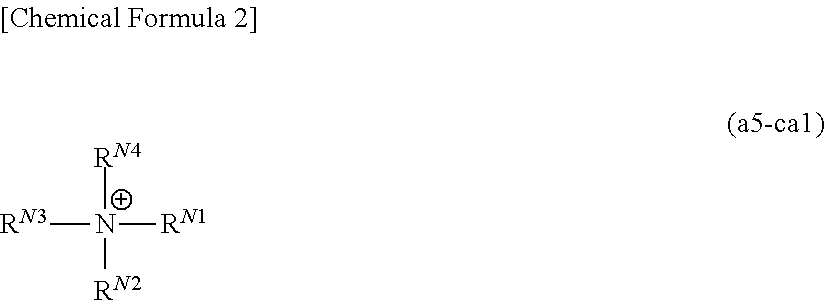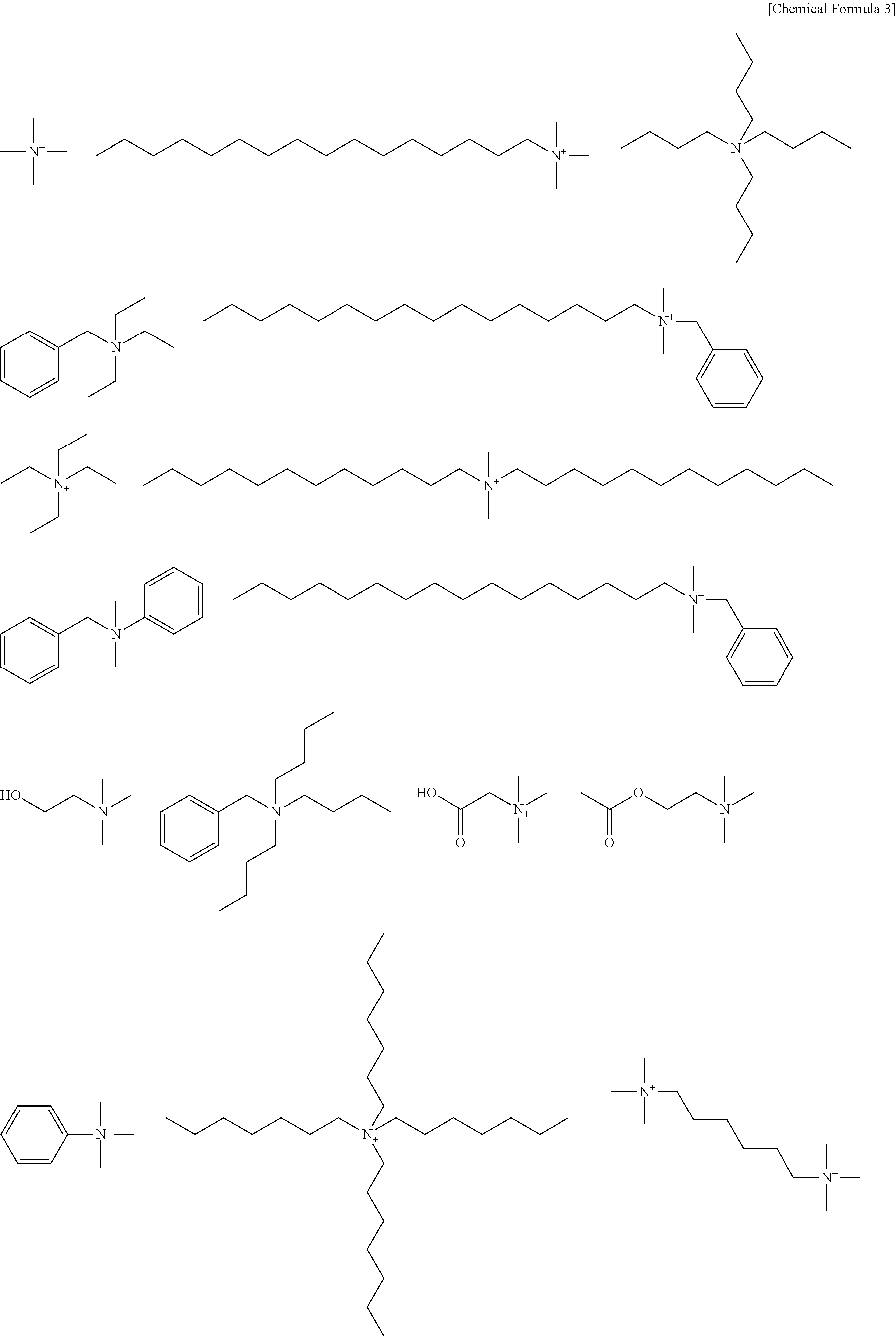Method of producing polymeric compound, resist composition, and method of forming resist pattern
a polymer compound and composition technology, applied in the field of producing polymeric compound, resist composition, and method of forming resist pattern, can solve the problems of difficult to achieve the desired lithography properties, poor removal efficiency of monomers containing acid-generating groups that generate acid upon exposure, and poor removal efficiency of monomers containing acid-generating groups. achieve excellent lithography properties
- Summary
- Abstract
- Description
- Claims
- Application Information
AI Technical Summary
Benefits of technology
Problems solved by technology
Method used
Image
Examples
example 1
Production of Polymeric Compound (1)
Step (i):
[0867]In a separable flask fitted with a thermometer, a reflux condenser and a nitrogen inlet tube, 38.00 g (120.13 mmol) of a compound (01), 61.10 g (232.84 mmol) of a compound (11) and 11.24 g (37.05 mmol) of a compound (51) were dissolved in 138.75 g of a mixed solvent of ethyl lactate and γ-butyrolactone (EL / GBL). As a polymerization initiator, 27.30 mmol of dimethyl azobisisobutyrate (V-601, manufactured by Wako Pure Chemical Industries, Ltd.) was then added to the resulting solution and dissolved.
[0868]This solution was then added dropwise, over 4 hours and under a nitrogen atmosphere, to 76.90 g of a mixed solvent of EL / GBL that had been heated to 80° C. Following completion of the dropwise addition, the reaction solution was stirred under heat for one hour, and the reaction solution was then cooled to room temperature.
[0869]Subsequently, the obtained polymerization reaction solution was added dropwise to a large volume of isopropa...
examples 2 to 34
Production of Polymeric Compounds (2) to (34)
[0875]With the exceptions of using compounds represented by chemical formulas shown below in the prescribed molar ratio as the monomers in the aforementioned step (i) of the example 1, and using compounds represented by chemical formulas (c1) to (c9) shown below as the compound used in the salt exchange of the aforementioned step (ii), polymeric compounds (2) to (34) were obtained in the same manner as the steps (i) to (iii) described above.
[0876]The monomers and salt exchange compound used in the production of each of the polymeric compounds (of the examples) are shown in Table 1.
[0877]Further, for the polymeric compound produced in each of the examples, the copolymer composition ratio (molar ratio) determined by carbon-13 nuclear magnetic resonance spectroscopy (600 MHz 13C-NMR), the polystyrene-equivalent weight-average molecular weight (Mw) determined by GPC measurement, and the molecular weight dispersity (Mw / Mn) are also shown in Ta...
examples 35 to 68
Comparative Examples 36 to 70]
[0896]The components shown in Table 3 were mixed together and dissolved to prepare resist compositions of an example 35 and a comparative example 36 respectively.
[0897]With the exceptions of replacing the component (A) with the polymeric compounds (2) to (34) and the polymeric compounds (2′) to (35′) described above respectively, resist compositions of examples 36 to 68 and comparative examples 37 to 70 were prepared in the same manner as that described for the resist compositions of the example 35 and the comparative example 36.
TABLE 3Com-Com-Com-ponentponentponentComponent(A)(D)(E)(S)Exam-(A)-1(D)-1(E)-1(S)-1(S)-2(S)-3(S)-4ple 35[100][1.60][0.64][200][2080][1250][830]Com-(A)-2(D)-1(E)-1(S)-1(S)-2(S)-3(S)-4parative[100][1.60][0.64][200][2080][1250][830]exam-ple 36
[0898]In Table 3, the numerical values in brackets [ ] indicate the amount (in parts by weight) of the component added. Further, the reference symbols in Table 3 have the meanings shown below....
PUM
| Property | Measurement | Unit |
|---|---|---|
| temperature | aaaaa | aaaaa |
| temperature | aaaaa | aaaaa |
| temperature | aaaaa | aaaaa |
Abstract
Description
Claims
Application Information
 Login to View More
Login to View More - R&D
- Intellectual Property
- Life Sciences
- Materials
- Tech Scout
- Unparalleled Data Quality
- Higher Quality Content
- 60% Fewer Hallucinations
Browse by: Latest US Patents, China's latest patents, Technical Efficacy Thesaurus, Application Domain, Technology Topic, Popular Technical Reports.
© 2025 PatSnap. All rights reserved.Legal|Privacy policy|Modern Slavery Act Transparency Statement|Sitemap|About US| Contact US: help@patsnap.com



